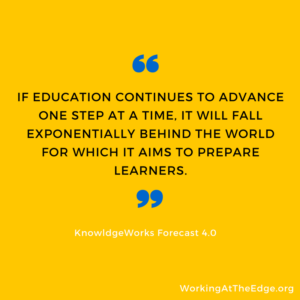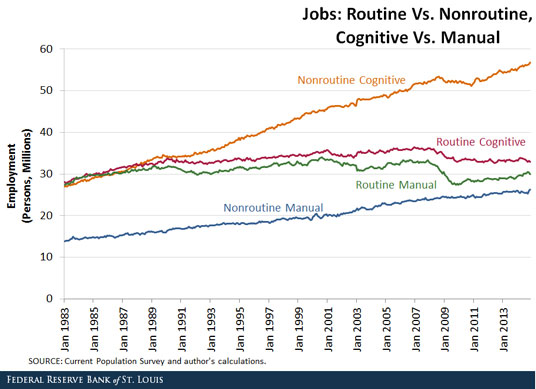 This post poses a series of questions designed to increase awareness of exponential change and how it might be applied to the practice of educational leadership. I’m still developing my thinking in this area, but wanted to share questions I’ve been mulling over as I believe we must find ways to bridge the exponential world with our traditionally linear schools. Here are some questions to get started on the journey!
This post poses a series of questions designed to increase awareness of exponential change and how it might be applied to the practice of educational leadership. I’m still developing my thinking in this area, but wanted to share questions I’ve been mulling over as I believe we must find ways to bridge the exponential world with our traditionally linear schools. Here are some questions to get started on the journey!
Are educators aware of the power of exponentials?
An explanation of the difference between linear and exponential thinking is included in KnowledgeWorks Forecast 4.o – The Future of Learning: Education in the Era of Partners in Code. The explanation can help us understand the differences between the two:
Imagine that you are claiming a staircase. You ascend at a steady rate one step after another. You reach the top and look back at your path 30 steps in a straight line that took you from one place to another. This type of linear change is normal to us because we see it every day. Whether we are climbing stairs, following a recipe, or watering a plant, clear cause-and-effect relationships abound, so our instinct is to apply that pattern to the world around us. Now imagine that, instead of taking one step at a time, you were climbing the stairs exponentially by doubling the number of steps you took each time. You would take one step, then another. Then you would take the next two at once. Then you would find yourself on step number eight, then step 16, all in the same amount of time it would have taken you to climb five steps one at a time.
This is the story of social, economic, and technological change in the 21st century. The rate at which new inventions, ideas, and marketplaces emerge and then become obsolete is accelerating, yet we often still think of ourselves as climbing a staircase, one step at a time, toward a faraway future. We are not following a clear path at a steady clip; we are speeding on an uncertain track at an exponential pace.
If education continues to advance one step at a time, it will fall exponentially behind the world for which it aims to prepare learners. (Adapted from Peter Diamandis’ illustration of exponential vs. linear change.)
Why should we care about exponentials?
Take a minute to study this graph from the Federal Reserve Bank of St. Louis.
Notice the stasis or decline in routine jobs over time. Also notice the increase in non-routine, particularly non-routine cognitive. This kind of work will likely continue to increase, requiring skills such as critical thinking, creativity and others that computers are not (yet) good at. How are our linear-thinking schools preparing learners to assume the fastest growing non-routine cognitive (which are changing exponentially)? Do the knowledge, skills and dispositions we want for our learners align with the expectations of non-routine cognitive work?
Is there a framework we can use to think about exponentials – technologies and processes – so that we might impact our practice and how we design a vision for learning?
In Bold: How to Go Big, Create Wealth, and Impact the World, Peter Diamandis and Steven Kotler propose the 6 Ds framework which consists of
- Digitization – Once a process or product transitions from physical to digital, it becomes exponentially empowered.
- Deception – Since the early stages of exponential growth are minimal, people can easily be deceived and ignore the change that is occurring until the innovation hits a tipping point.
- Disruption – The innovation creates a new market that disrupts an old one.
- Demonitization – The cost of the innovation decreases in relation to the exponential increases in growth.
- Dematerialization – The innovation leads to the vanishing of goods and services.
- Deomcratization – The cost of the innovation goes so low that it is available to just about anyone.
The authors walk us through the 6Ds framework using the demise of Kodak, physical cameras and the disruption caused by digital photography.
What are some examples of exponentials outside of school and how might they help move us closer toward exponential practices inside of school?
- Artificial intelligence – How will AI help us teach to learner passions, interests and needs? How will AI democratize education – for the poorest child to the richest child? I wonder whether society is ready to democratize education based on the current political climate of many countries around the world.
- Virtual reality – Google is in the process of imaging the world in high resolution. Our learners will soon be able to explore and feel like they are in any place in the world because these high resolution images will be used to create all kinds of VR learning environments. I wonder how VR will help us teach empathy. What’s it like to be an immigrant? What’s it like to be a person of the opposite gender?
- Robotics – Peter Diamandis thinks that robots will take the place of things that are dangerous, dull or dirty. Are we teaching our kids to think about, play with and interact with robotics?
- 3D printing – We can currently use 3D printing to take our ideas and physically manifest them. How might 3D printing merge with virtual reality and augmented reality?
While it’s beyond the scope of this post to apply the 6Ds framework to each exponential technology, it’s fun to dig deeper, thinking about phases of deception, disruption, etc. for each. This can be challenging, however, because we are working in such a highly regulated, linear thinking system. Give it a go and build your exponential thinking mindset! I have found it interesting to think about how the rise (some might say, exponential rise) of these technologies in education reinforces our beliefs about learning.
What other examples of exponentials are on your radar? Does the 6 Ds Framework add value to your understanding of the exponential? How do the exponentials intersect with your beliefs about learning?
Connect with Randy on Twitter and on the TLTalkRadio podcast!
Get new content delivered to your inbox and the ebook 3 Key Principles of Digital Transformation. The ebook contains valuable information from my experience leading a digital transformation and working with a variety of stakeholders over the past decade.
- A silver lining - January 22, 2022
- Is our use of tech working against us? 🤔 - September 8, 2021
- What’s NOT going to change in the next 10 years? 🤔 - September 7, 2021
